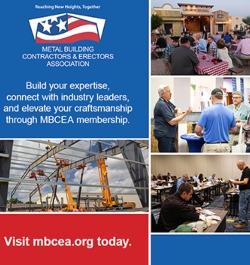UP TO THE MINUTE
Changes in Technology Make Construction Projects More Efficient

MCS Influencer Mark Standifer says that all sectors of the metal construction industry have been impacted by the growth of technology.
Before I get into this month’s topic, congratulations to the Student Roofing Competition Teams that have made it to the finals. Those schools are Bradley University, California Polytechnic University, Clemson University, Colorado State University, the University of Florida and Texas A & M University (Old Army Roofing). Next month, while at the International Roofing Expo (IRE) in Dallas, Texas, schedule the time to attend the student presentations, the last part of the competition. GIG’EM AGGIES!! WHOOP!
This month’s topic is how technology has changed the metal roofing/siding business. I’ll touch on the technological changes in the estimator’s office, the sheet metal shop and field installation. Most recent changes revolve around the use of the computer and how it has increased productivity.
Changes in the estimator’s office have progressed greatly since I got in this business in 1985. As an example, I’ll discuss the first sheet metal job I estimated. In order to perform the quantity survey, I used paper plans, an architect’s scale, pen, paper and my Hewlitt Packard calculator. With these tools, I determined the roof area, lineal feet of the required trim and flashing, as well as the number of rolls of 30# felt, boards of insulation, number of roof clips, fasteners and the other accessories, needed for a complete project. This was all done by hand, using paper plans. The cost of flat sheets and shop fabrication was priced by hand, using an old-fashioned, paper spreadsheet. To determine the actual cost of the project, I used a company-designed spreadsheet (still on paper). On this form, I manually listed the parts and pieces with the appropriate cost to get a bid price. After determining a cost for the roof, I called in my bid, using a landline, to the general contractors. A written proposal was sent if a general contractor requested one. These proposals were hand-delivered.
In the late '80s early '90s, the digitizer was starting to be used to provide the quantities. I still had to know how to use a scale. At this time, using my calculator, I updated my spreadsheet (still on paper), to determine the cost, all by hand. Now a written proposal was sent via the fax machine.
With the technological advancements, plans and specifications are being sent electronically to the estimator. Then using one of the many estimating programs on the market, the estimator can quickly complete the quantity survey. If the estimator has entered the correct data/information into the program, and has a current data base with current material prices, by the time the survey is complete, material pricing will only require “tweaking” to be priced. It’s important to emphasize that the wrong and/or incorrect information, pricing or some other data entry will result in a bid with an error. Think, garbage in, garbage out. The paper spreadsheet has been replaced with an electronic template designed by the company for use in pricing. It’s user-friendly and easy to customize for each project, calculating flat sheets and shop fabrication cost. The written proposal can be generated by the completed template. The document is now e-mailed to the general contractor.
The sheet metal shop has also been affected by technology. The electric slitters and hand brakes have been replaced by computer numerically controlled shears and brakes. Some computerized brakes are capable of storing 99 shapes with up to X number of operations per shape. This automation insures a certain amount of quality control and repeatability. Now the sheet metal shop is able to exactly duplicate a replacement piece, in the event of loss or damage. With a trained operator, half-round gutter can be fabricated on the newer brakes. There is some very sophisticated equipment that can form the entire shape. Battery-operated hand tools have taken their place in the sheet metal shop. The use of equipment that needs a cord is typically limited to larger hand tools.
Battery-powered screw guns and drills have also made their way onto the job site. The use of a tool that requires a cord for power, is rarely seen on the roof. The days of a roof covered with electrical cords (trip hazard) is a thing of past.
On jobsites now, you might see an installer using a tablet to clarify a specific condition detail. A picture can be taken and sent directly to the field superintendent, to provide a clear picture of the condition in question. If the issue is a quick fix, the solution is sent back to the field without a big hit to productivity. If the issue IS NOT a quick fix, and additional thought is required, the superintendent and/or project manager can start working on the solution immediately.
The technological advances provided by the computer will continue to change this industry, from the estimator’s office, to the sheet metal shop, and the field. It’s possible that one day a robot similar to Boston Dynamics’ Atlas could be used to install roof panels. Imagine a future where pre-programmed or remote-controlled drones will be used to load the roofing materials. One day we’ll be asking Scotty to “beam up” the roof panels to the roof deck.
I’m going to close with the following. Think about the technological changes in the past century and this new one. I had a grandmother, who during her lifetime heard about the Wright brothers flying; she saw us put a man on the moon before she passed. During my lifetime I’ve seen the television change from something the size of a washing machine with a picture the size of your phone, to refrigerator-sized units that hang on the wall. What changes in technology will take place during your life?
Mark Standifer is the project manager of King of Texas Roofing. See his full bio here.



















Comments
Leave a Reply
Have an account? Login to leave a comment!
Sign In